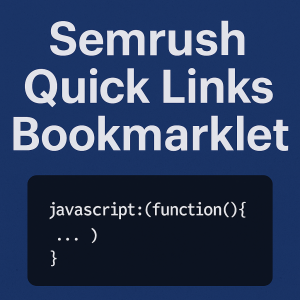Hot off the predictions I shared for AI Overviews last week, we have more data about how AIOs are evolving in the Google landscape.
Google’s AI Overviews and why they matter
Google’s search results are evolving faster than ever, and one of the biggest recent changes is the rollout of AI-generated overviews. These are concise, AI-powered summaries appearing directly in search results, designed to quickly answer user queries without requiring a click through to external websites.
Recently, Semrush conducted a study to investigate how widespread these AI Overviews have become and their potential impact across different industries. Their findings show a significant shift in the way users engage with search results, underscoring the need for SEOs and content creators to adapt quickly.
In this week’s note I’m going to dive into Semrush’s key findings and explore what these AI Overviews mean for your SEO strategy, and how you can stay ahead as Google’s search experience continues to evolve.
I would encourage you to read the full study for yourself.
Key findings from the Semrush study
The recent Semrush study uncovered several important insights into how Google’s AI-generated search overviews are reshaping search visibility. Here are some of the highlights:
- AI Overviews are becoming increasingly common:
In fact, 13.14% of all queries triggered AI Overviews in March 2025, up from just 6.49% in January. That’s more than double in two months. If you were looking for a sign that this is not just a test, there it is. It is the future of the SERP. - Health, Finance, and Technology industries see significant impact:
Certain industries are experiencing more disruption than others. For example, searches in the health sector saw around a 20% increase in AI Overview visibility. Finance and technology sectors are similarly affected, with AI summaries appearing frequently, reducing the visibility of traditional listings. - Reduced visibility for traditional search results:
With AI summaries taking prime real estate at the top of search results, there’s a measurable decrease in visibility and click-through rates for regular organic results. This shift emphasizes the importance of securing featured snippets and other prominent search features. - User engagement is changing:
The way users interact with SERPs (Search Engine Results Pages) is evolving. AI-generated overviews are quickly providing the answers users seek, often without the need for additional clicks. This behavior potentially reduces traffic to traditional pages unless strategies adapt. - AI Overviews in navigational searches is still low, but on the rise:
While informational queries dominate, the number of navigational searches triggering AI Overviews has doubled since January, rising from 0.74% to 1.43%. This signals that AI summaries are expanding beyond just general knowledge answers.
These findings highlight a significant evolution in search, urging SEOs and content marketers to rethink their approach to remain competitive.
Why SEOs and content creators should pay attention
Google’s increased use of AI Overviews isn’t just a minor SERP adjustment. It’s a fundamental shift in how search engines present information. As an SEO professional or content creator, here’s why this change matters to you:
- Visibility and CTR are at stake:
AI Overviews dominate the top positions in SERPs, capturing user attention immediately. Traditional organic results and even featured snippets are pushed further down, leading to reduced click-through rates (CTR) and visibility for standard listings. - Increased importance of featured snippets:
With AI-generated summaries taking center stage, featured snippets become even more critical (for now). If your content isn’t optimized to provide quick, concise answers that Google’s AI can leverage, you risk losing valuable real estate at the top of the page. As I said in last week’s note though, I think featured snippets will be deprecated in the next 12 months or so. - Content formatting and clarity matter more than ever:
AI Overviews typically draw from content that’s structured clearly, concisely, and accurately. SEOs and content creators must now place an even stronger focus on creating content that is not only helpful to readers but also easy for AI systems to summarize and present effectively. - Shifts in keyword strategy:
As Google’s AI evolves, keyword strategies will need adjustment. Instead of focusing exclusively on high-volume, generic keywords, content creators will need to identify and target more precise, intent-driven queries that are likely to trigger AI Overviews and featured snippets. Notably, 88.1% of queries that trigger an AI Overview are informational. That means blog posts, how-tos, and educational content are the most likely to be summarized—exactly the kind of content many SEOs rely on for top-of-funnel traffic.
How to optimize for AI Overviews
With AIOs now appearing across a growing share of search results, it’s time to adjust your SEO strategy to match how Google is presenting information. Whether you’re targeting featured snippets or aiming to appear in AI Overviews, the approach is largely the same: be clear, structured, and helpful.
Here’s how to align your content for this shift:
- Target Queries That Trigger AI Overviews:
Use tools like Semrush to identify which of your target keywords are showing AI summaries. These are the queries where you’re most at risk of losing visibility, or where you have an opportunity to claim it. - Answer Questions Clearly and Quickly:
Content that gets featured tends to answer the search query directly and concisely, often within the first 100 words. Use plain language and front-load your answers. - Use Structured Formatting:
Bullet points, numbered lists, and H2/H3 subheadings make it easier for Google’s AI (and users) to extract key takeaways. Pages with strong formatting are more likely to be summarized. - Optimize for Featured Snippets:
Even though AI Overviews are generated separately, much of the same logic applies. Create content blocks designed to answer specific questions in 40–60 word summaries. - Implement Structured Data Markup:
Use schema to help Google’s AI understand your content type and context. FAQs, how-to articles, product reviews, and definitions are great use cases. - Build Topical Authority:
Google’s AI pulls from sources it trusts. Publishing a cluster of high-quality content around a topic increases your chances of being included in AI-generated answers. - Monitor and Adapt:
Keep an eye on your rankings, CTR, and impressions in Search Console. Drops in traffic might not be due to ranking loss. They could be the result of an AI Overview replacing the organic click opportunity.
This shift doesn’t mean SEO is dead. It means SEO is evolving. The sites that succeed in an AI-first search environment will be the ones that write for both users and machines: structured, concise, and deeply useful.
Final thoughts: SEO in the age of AI Overviews
Google’s AI Overviews aren’t just another SERP feature. They are reshaping how information is delivered, how users interact with search results, and how websites earn visibility. The growth is rapid, and the impact is clear.
What started as a limited experiment is now scaling fast: over 13% of all queries triggered AI Overviews as of March 2025. That is double what we saw just two months prior. And it’s not just informational queries anymore. Even navigational searches are being summarized by AI.
This is no longer a trend to watch. It is a shift to adapt to.
If your content strategy still relies on users clicking through standard 10-blue-link results, it’s time to evolve. Focus on being the source AI draws from. That means:
- Writing clear, structured, authoritative content
- Targeting high-intent informational queries
- Optimizing for featured snippets and answer boxes
- Building topical depth and trustworthiness
SEO isn’t going away. But the rules are changing. And the brands that understand how to work with Google’s AI, not against it, will be the ones that continue to win visibility, traffic, and trust in the years ahead.



